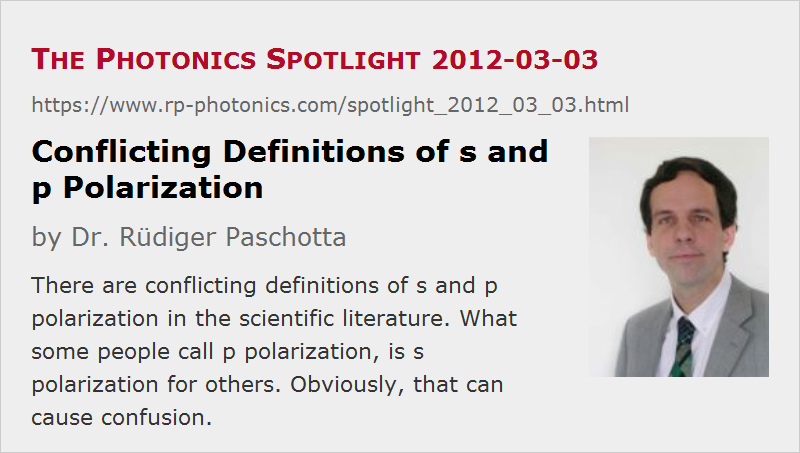Conflicting Definitions of s and p Polarization
Posted on 2012-03-03 as a part of the Photonics Spotlight (available as e-mail newsletter!)
Permanent link: https://www.rp-photonics.com/spotlight_2012_03_03.html
Author: Dr. Rüdiger Paschotta, RP Photonics Consulting GmbH
Abstract: There are conflicting definitions of s and p polarization in the scientific literature. What some people call p polarization, is s polarization for others. Obviously, that can cause confusion.

It is quite common to talk about s-polarized and p-polarized laser beams, incident on optical surfaces or diffraction gratings. Therefore, it is quite disturbing that there are conflicting definitions in the scientific literature:
- Usually, p-polarized light is understood to have an electric field direction parallel to the plane of incidence on a device, and s-polarized light has the electric field oriented perpendicular to that plane. (Actually, the letters have a German origin: s = senkrecht = perpendicular, p = parallel.) According to that definition, we can obtain vanishing reflectivity of a surface at Brewster's angle for p polarization. That's easy to remember: “p” is closer to “B” (like “Brewster”), so Brewster's trick works with p polarization.
- In the context of diffraction gratings, the opposite definition can be found. Here, “s” still means perpendicular, but in that case perpendicular not to the plane of incidence, but to the lines of the grating. So for s polarization, the electric field vector is perpendicular to the lines, i.e., it lies in the plane of incidence.
So there is another trap to fall into! When reading some paper, we have to find out which definition has been used.
By the way, some people call a laser beam s-polarized, when its polarization is vertical, i.e., perpendicular to the lab's floor. It is better, though, to restrict the terms s polarization and p polarization to cases where the polarization direction with respect to a plane of incidence is relevant. For example, if you have a Brewster-angled prism in the common orientation where the reflected beam stays horizontal in direction, s polarization according to the first definition above is vertical. However, if you turn the prism such that the reflected beam goes upwards, that will change, of course.
This article is a posting of the Photonics Spotlight, authored by Dr. Rüdiger Paschotta. You may link to this page and cite it, because its location is permanent. See also the RP Photonics Encyclopedia.
Note that you can also receive the articles in the form of a newsletter or with an RSS feed.
Questions and Comments from Users
Here you can submit questions and comments. As far as they get accepted by the author, they will appear above this paragraph together with the author’s answer. The author will decide on acceptance based on certain criteria. Essentially, the issue must be of sufficiently broad interest.
Please do not enter personal data here; we would otherwise delete it soon. (See also our privacy declaration.) If you wish to receive personal feedback or consultancy from the author, please contact him e.g. via e-mail.
By submitting the information, you give your consent to the potential publication of your inputs on our website according to our rules. (If you later retract your consent, we will delete those inputs.) As your inputs are first reviewed by the author, they may be published with some delay.
 |





If you like this page, please share the link with your friends and colleagues, e.g. via social media:
These sharing buttons are implemented in a privacy-friendly way!